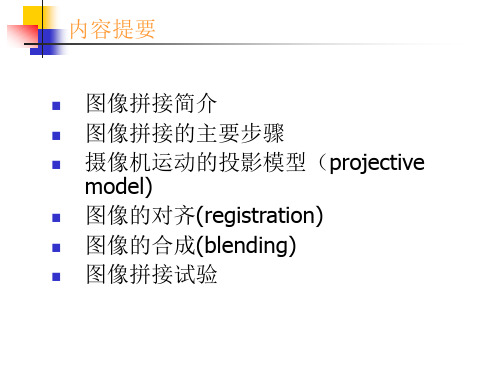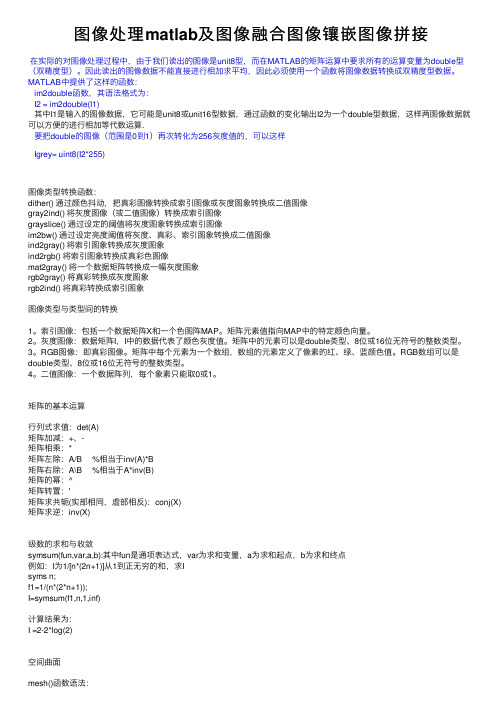matlab的图像拼接程序(20210119152549)
matlab图像拼接算法

对齐算法流程
投影到统一坐标系
初始变换矩阵M 初始变换矩阵
非线性最小 二乘法进行 优化
图像合成
最终变换矩阵M 最终变换矩阵
初始变换矩阵的获取 初始变换矩阵M可以通过提取特征点或者在 频域上计算两幅图像的相位相关等方法来 得到。 MATLAB中内建有cpselect函数,该函数允 许用户在将要拼接的两幅图像的重叠区域 中手工选取一定数量的匹配特征点对然后 自动给出两幅图像之间的初始变换矩阵。
内容提要 图像拼接简介 图像拼接的主要步骤 摄像机运动的投影模型(projective model) 图像的对齐(registration) 图像的合成(blending) 图像拼接试验
图像拼接简介
什么是图像拼接?
将多幅在不同时刻、从不同视 角或者由不同传感器获得的图像 经过对齐然后无缝地融合在一起, 从而得到一幅大视场、高分辨率 图像的处理过程。该图像被称为 全景图。
摄像机运动模型
homography
摄像机的8-参数运动模型源自常见的几种几何变换:平移 (translation)
旋转 (rotation)
水平切变 (horizontal shear)
投影 (projection)
8-参数运动模型
假设 p ' ( x' , y ' )T 和 p = ( x, y ) 分别是一个象素点的新旧坐 标,一个二维仿射变换可以写为: p ' = Mp + t 或是 x' = a11 a12 x + t x y' a a22 y t y 21
m0 = m3 m 6
m1 m4 m7
在Matlab中进行图像融合与图像叠加的方法与技巧

在Matlab中进行图像融合与图像叠加的方法与技巧引言:随着数字图像处理和计算机视觉领域的发展,图像融合和图像叠加变得越来越重要。
图像融合是指将多幅图像合成为一幅具有更清晰、更丰富信息的图像,而图像叠加则是在保留所叠加图像的原始信息的同时,使图像更加丰富和易于理解。
Matlab作为一种强大的科学计算工具,提供了丰富的图像处理函数和工具箱,可以很方便地进行图像融合与图像叠加。
一、图像融合的方法与技巧1. 融合算法图像融合的基本方法有加权平均法、空间域融合法、频域融合法、小波融合法等。
加权平均法是最简单的方法,通过计算图像像素的平均值来融合。
空间域融合法是通过对直接融合的图像进行空间域操作来提取融合结果。
频域融合法则是通过将图像转换到频域,然后进行频域操作来实现融合。
小波融合法是基于小波变换的方法,利用小波分析的多尺度分解能力对图像进行分析和融合。
根据具体需求和图像的特点,选择合适的融合算法是非常重要的。
2. 图像预处理在进行图像融合之前,通常需要进行图像预处理,以提高融合结果的质量。
常用的图像预处理方法包括灰度拉伸、直方图均衡化、滤波等。
灰度拉伸是通过对图像的像素值进行线性变换,将图像像素值的范围拉伸到合适的范围内,从而增加图像的对比度。
直方图均衡化则是将图像的像素值在灰度直方图上均匀分布,以增强图像的细节。
滤波是通过对图像进行滤波操作,如低通滤波、高通滤波等,以去除图像中的噪声和不需要的细节。
3. 图像融合的策略图像融合的策略可以根据具体需求来选择。
常见的策略包括全局融合和局部融合。
全局融合是将所有图像的信息进行融合,得到整体的融合结果。
而局部融合则是将不同图像的不同区域进行融合,以保留更多的细节和纹理。
根据具体应用和需求,选择合适的融合策略可以使融合结果更加符合实际需求。
4. 参数设置与调整在进行图像融合过程中,不同的算法和方法有各自的参数,根据不同的图像和具体应用,需要适时地进行参数的设置和调整。
图像处理matlab及图像融合图像镶嵌图像拼接

图像处理matlab及图像融合图像镶嵌图像拼接在实际的对图像处理过程中,由于我们读出的图像是unit8型,⽽在MATLAB的矩阵运算中要求所有的运算变量为double型(双精度型)。
因此读出的图像数据不能直接进⾏相加求平均,因此必须使⽤⼀个函数将图像数据转换成双精度型数据。
MATLAB中提供了这样的函数:im2double函数,其语法格式为:I2 = im2double(I1)其中I1是输⼊的图像数据,它可能是unit8或unit16型数据,通过函数的变化输出I2为⼀个double型数据,这样两图像数据就可以⽅便的进⾏相加等代数运算.要把double的图像(范围是0到1)再次转化为256灰度值的,可以这样Igrey= uint8(I2*255)图像类型转换函数:dither() 通过颜⾊抖动,把真彩图像转换成索引图像或灰度图象转换成⼆值图像gray2ind() 将灰度图像(或⼆值图像)转换成索引图像grayslice() 通过设定的阈值将灰度图象转换成索引图像im2bw() 通过设定亮度阈值将灰度、真彩、索引图象转换成⼆值图像ind2gray() 将索引图象转换成灰度图象ind2rgb() 将索引图象转换成真彩⾊图像mat2gray() 将⼀个数据矩阵转换成⼀幅灰度图象rgb2gray() 将真彩转换成灰度图象rgb2ind() 将真彩转换成索引图象图像类型与类型间的转换1。
索引图像:包括⼀个数据矩阵X和⼀个⾊图阵MAP。
矩阵元素值指向MAP中的特定颜⾊向量。
2。
灰度图像:数据矩阵I,I中的数据代表了颜⾊灰度值。
矩阵中的元素可以是double类型、8位或16位⽆符号的整数类型。
3。
RGB图像:即真彩图像。
矩阵中每个元素为⼀个数组,数组的元素定义了像素的红、绿、蓝颜⾊值。
RGB数组可以是double类型、8位或16位⽆符号的整数类型。
4。
⼆值图像:⼀个数据阵列,每个象素只能取0或1。
矩阵的基本运算⾏列式求值:det(A)矩阵加减:+、-矩阵相乘:*矩阵左除:A/B %相当于inv(A)*B矩阵右除:A\B %相当于A*inv(B)矩阵的幂:^矩阵转置:'矩阵求共轭(实部相同,虚部相反):conj(X)矩阵求逆:inv(X)级数的求和与收敛symsum(fun,var,a,b):其中fun是通项表达式,var为求和变量,a为求和起点,b为求和终点例如:I为1/[n*(2n+1)]从1到正⽆穷的和,求Isyms n;f1=1/(n*(2*n+1));I=symsum(f1,n,1,inf)计算结果为:I =2-2*log(2)空间曲⾯mesh()函数语法:mesh(Z):mesh(X,Y,Z,C):其中C是⽤来定义相应点颜⾊等属性的数组例:求x^2+y^2=z的空间曲⾯x=-4:4;y=x;[X,Y]=meshgrid(x,y);%⽣成x,y坐标Z=X.^2+Y.^2;mesh(X,Y,Z)曲⾯图[x,y]=meshgrid(xa,ya) 当xa,ya分别为m维和n维⾏向量,得到x和y均为n⾏m列矩阵。
如何使用Matlab进行图像拼接和图像融合技术实现

如何使用Matlab进行图像拼接和图像融合技术实现引言:随着数字图像处理的快速发展,图像拼接和融合技术在许多领域中得到了广泛应用,如航空摄影、医学影像和虚拟现实等。
在本文中,我们将探讨如何使用Matlab软件来实现图像拼接和图像融合的技术。
通过学习这些技术,您将能够将多个图像合并为一个大的全景图像,并且可以通过融合不同曝光或不同焦距拍摄的图像来得到一个更高质量的图像。
一、图像拼接技术图像拼接是将多幅图像无缝合并为一个更大的全景图像的过程。
在Matlab中,可以通过以下步骤进行图像拼接:1. 加载图像:使用imread函数加载所有待拼接的图像。
确保拼接的图像具有重叠区域。
2. 检测特征点:使用SURF(Speeded-Up Robust Features)等特征检测算法在每个图像中找到相应的特征点。
Matlab中提供了现成的函数,如detectSURFFeatures和extractFeatures等。
3. 匹配特征点:使用特征描述符算法(如SURF)比较两幅图像的特征点,并找到相似的特征点。
Matlab中提供了matchFeatures函数来实现。
4. 估计变换矩阵:使用RANSAC算法估计两幅图像之间的单应性变换矩阵,该矩阵描述了如何将一个图像变换到另一个图像中。
Matlab中的estimateGeometricTransform函数可以实现这一步骤。
5. 图像拼接:使用warping技术将所有图像根据变换矩阵进行变换,并将它们拼接在一起。
Matlab提供了warp函数来实现这一过程。
6. 调整拼接后的图像:根据需求,使用imcrop函数对拼接图像进行裁剪,并使用imresize函数调整尺寸。
通过以上步骤,您可以使用Matlab实现图像拼接技术,并得到一个无缝连接的全景图像。
二、图像融合技术图像融合是将不同曝光或不同焦距下拍摄的图像进行融合,以得到更高质量的图像。
在Matlab中,可以通过以下步骤实现图像融合:1. 加载图像:使用imread函数加载待融合的图像。
Matlab中的图像配对和立体视觉分析技巧

Matlab中的图像配对和立体视觉分析技巧Matlab作为一款功能强大的科学计算软件,广泛应用于图像处理和计算机视觉领域。
本文将介绍Matlab中的图像配对和立体视觉分析技巧,帮助读者深入了解和运用这些技术。
一、图像配对技巧图像配对是指将两个或多个图像进行匹配、对齐或比较的过程。
在计算机视觉和图像处理领域,图像配对是一项基本任务,应用广泛。
而Matlab提供了许多强大的函数和工具箱来实现图像配对。
首先,图像预处理是图像配对的关键步骤。
在Matlab中,可以使用imread函数读取图像,并使用imresize函数进行图像大小的调整。
此外,还可以使用imadjust函数进行图像的亮度、对比度调整,以便更好地进行后续处理。
其次,Matlab提供了多种图像配对算法,如最小二乘法、局部敏感哈希(LSH)和支持向量机(SVM)等。
其中,最小二乘法是一种常用的线性回归方法,可以用于图像的几何校正和配准。
而LSH和SVM则主要用于图像的相似性匹配和分类。
另外,Matlab还提供了一些特征提取和匹配函数,如Harris角点检测、SIFT特征提取和RANSAC算法等。
这些函数可以帮助用户从图像中提取关键特征,并找到图像之间的对应关系,从而实现图像配对。
最后,Matlab还支持通过可视化展示来进行图像配对结果的分析和评估。
用户可以使用imshow函数显示图像,使用plot函数绘制关键特征点,并使用imblend函数将配对结果进行融合。
此外,还可以使用imhist函数绘制图像的直方图,用于对比不同图像之间的差异。
二、立体视觉分析技巧立体视觉分析是指通过两个或多个视觉传感器获取的图像,计算出相应物体的三维信息的过程。
在Matlab中,也提供了许多用于立体视觉分析的函数和工具箱,帮助用户实现立体视觉处理。
首先,图像校正是立体视觉分析的基础步骤。
在Matlab中,可以使用stereoRectify函数进行图像的校正,从而消除因视角不同而引起的畸变和误差。
最新MATLAB图像拼接算法及实现

M A T L A B图像拼接算法及实现图像拼接算法及实现(一)论文关键词:图像拼接图像配准图像融合全景图论文摘要:图像拼接(image mosaic)技术是将一组相互间重叠部分的图像序列进行空间匹配对准,经重采样合成后形成一幅包含各图像序列信息的宽视角场景的、完整的、高清晰的新图像的技术。
图像拼接在摄影测量学、计算机视觉、遥感图像处理、医学图像分析、计算机图形学等领域有着广泛的应用价值。
一般来说,图像拼接的过程由图像获取,图像配准,图像合成三步骤组成,其中图像配准是整个图像拼接的基础。
本文研究了两种图像配准算法:基于特征和基于变换域的图像配准算法。
在基于特征的配准算法的基础上,提出一种稳健的基于特征点的配准算法。
首先改进Harris角点检测算法,有效提高所提取特征点的速度和精度。
然后利用相似测度NCC(normalized cross correlation——归一化互相关),通过用双向最大相关系数匹配的方法提取出初始特征点对,用随机采样法RANSAC(Random Sample Consensus)剔除伪特征点对,实现特征点对的精确匹配。
最后用正确的特征点匹配对实现图像的配准。
本文提出的算法适应性较强,在重复性纹理、旋转角度比较大等较难自动匹配场合下仍可以准确实现图像配准。
Abstract:Image mosaic is a technology that carries on the spatial matching to aseries of image which are overlapped with each other, and finally builds a seamless and high quality image which has high resolution and big eyeshot. Image mosaic has widely applications in the fields of photogrammetry, computer vision, remote sensingimage processing, medical image analysis, computer graphic and so on. 。
Matlab中的图像拼接与合成方法

Matlab中的图像拼接与合成方法图像拼接和合成是数字图像处理中的重要技术,在许多领域都有广泛的应用,如计算机视觉、图形学、遥感和医学图像等。
在Matlab中,我们可以利用一些强大的工具和函数来实现图像拼接与合成。
一、图像的基本处理在进行图像拼接与合成之前,我们需要先对待处理的图像进行一些基本的预处理,比如图像的读取、转换、调整和裁剪等。
Matlab提供了丰富的函数和工具箱来完成这些任务。
1. 图像读取与转换Matlab中可以使用imread函数来读取图像,支持多种图像格式,如JPEG、PNG和BMP等。
读取后的图像可以保存在一个矩阵中,每个像素的值代表该位置的颜色信息。
读取图像示例代码:image = imread('image.jpg');对于彩色图像,可以使用rgb2gray函数将图像转换成灰度图像,方便后续处理。
转换为灰度图像示例代码:gray_image = rgb2gray(image);2. 图像调整与裁剪Matlab中提供了imresize函数来调整图像大小,可以根据比例因子或指定的尺寸来调整图像。
另外,还可以使用imcrop函数来裁剪图像,根据指定的位置和尺寸来截取感兴趣的部分。
调整图像大小示例代码:resized_image = imresize(image, 0.5); % 缩小为原来的一半裁剪图像示例代码:cropped_image = imcrop(image, [x, y, width, height]); % 截取位置为(x, y),尺寸为width x height的图像二、图像拼接方法图像拼接是将多幅图像按照一定的规则拼接在一起,构成一幅更大的图像。
Matlab中有多种方法可以实现图像的拼接,常用的方法包括简单的几何变换、局部特征匹配和全局优化方法等。
1. 简单的几何变换最简单的图像拼接方法是通过几何变换将多幅图像对齐,然后将它们合并在一起。
在Matlab中,可以使用imtransform函数来进行几何变换,常见的变换包括平移、旋转、缩放和翻转等。
如何使用MATLAB进行图像拼接和合成

如何使用MATLAB进行图像拼接和合成概述:图像拼接和合成是一种将多张图片融合成一张完整图片的技术。
MATLAB作为一种功能强大的科学计算软件,提供了许多方便易用的工具包,使得图像拼接和合成变得更加简单。
本文将介绍如何使用MATLAB进行图像拼接和合成的方法和技巧。
一、图像预处理:在进行图像拼接和合成之前,首先需要对原始输入进行一系列的预处理。
这包括图像的尺寸统一、色彩平衡和去噪等操作。
MATLAB提供了许多内置函数和工具箱,可以轻松完成这些预处理工作。
1. 图像尺寸统一:由于不同图片可能具有不同的尺寸和比例,为了实现拼接和合成的目标,我们需要将所有输入图片的尺寸统一。
MATLAB中的imresize函数可以很方便地实现图像的缩放操作,使得所有图像具有相同的尺寸。
2. 色彩平衡:当合成图像中不同部分的色彩不匹配时,我们需要进行色彩平衡操作,使得整体图像具有统一的色调。
MATLAB提供了imadjust函数,可以对图像的亮度和对比度进行调整,以达到色彩平衡的效果。
3. 去噪:在拼接和合成图像时,由于图片在拍摄和处理过程中可能会出现噪点和不完整的部分,我们需要使用去噪算法来提高图像质量。
MATLAB中的imfilter函数可以实现常见的去噪算法,如中值滤波和高斯滤波等。
二、图像拼接:图像拼接是将多个图片按照一定规则拼接成一张完整图片的过程。
MATLAB 提供了多种实现图像拼接的函数和技术,下面列举其中几种常见的方法。
1. 水平拼接:水平拼接是将多张图片按照水平方向排列,形成一张更宽的图片。
MATLAB 中的imresize和imwrite函数可以实现此功能。
首先,将所有输入图片调整为相同的高度和宽度,然后调用imwrite函数将它们水平排列在一起。
2. 垂直拼接:垂直拼接是将多张图片按照垂直方向排列,形成一张更高的图片。
与水平拼接类似,需要先调整所有输入图片为相同的高度和宽度,然后使用imwrite函数将它们垂直排列在一起。
- 1、下载文档前请自行甄别文档内容的完整性,平台不提供额外的编辑、内容补充、找答案等附加服务。
- 2、"仅部分预览"的文档,不可在线预览部分如存在完整性等问题,可反馈申请退款(可完整预览的文档不适用该条件!)。
- 3、如文档侵犯您的权益,请联系客服反馈,我们会尽快为您处理(人工客服工作时间:9:00-18:30)。
mat lab的图像拼接程
序
-CAL-FENGHAI-(2020YEAR-YICAI) JINGBIAN
ll=imread{,,);%6dTAEuODpAp¥dy2All%6D j u j A
ll=double(ll);
[hl wl dl]=size(ll);%TEOEdl±al2lldU±a>>0dl
I2= imread(n);
I2=double(l2);
[h2 w2 d2]=size(l2);
%show input images and prompt for correspondences figure;subplot( 1,2,1); image(ll/255); axis image; hold on; title(*first input image');
[XI Yl]=ginput(2); %get two points from the usersubplot(l z2,2); image(l2/255); axis image; hold on;
title('sec ond input image*);
[X2 Y2]=ginput(2); %get two points from the user %estimate parameter vector(t);
Z=[X2' Y2'; Y2'・X2'; HOOjOOll]1;
xp=[Xl; Yl];
t=Z\xp; %solve the I in ear system
a=t(l); %=s cos(alpha)
b=t(2);%=s sin(alpha)
tx=t(3);
ty=t(4);
% con struct transformation matrix(T)
T=[a b tx;・b a ty; 0 0 1];
% warp incoming corners to determine the size of the output image(in to out) cp二T*[l 1 w2 w2; 1 h2 1 h2; 1 111];
Xpr=min([cp(l/:)/O]): max([cp(l/:)/wl]);%min x:maxx
Ypr=min([cp(2/:)/0]): max([cp(2/:)/hl]); %min y: max y [Xp/Yp]=ndgrid(Xpr/ Ypr);
[wp hp]=size(Xp); %=size(Yp)
% do backwards transform (from out to in)
X=T\[Xp(:) Yp(:) ones(wp*hp/l)]';%warp
%re-sample pixel values with bilinear interpolation
clear Ip;
xl二reshape(X(b:)Mp,hp)‘;
yl=reshape(X(2/:)/wp/hp)1;
lp(:/:/l)=interp2(l2(:/:/l)/xl/ yl, '♦bilinear*); %red
Ip(:/:/2)=interp2(l2(:/:/2)/xl/ yl, '♦bilinear1);%green lp(:z:/3)=interp2(l2(:/:/3)/xl/ yl, ^bilinear1);%blue
% offset and copy original image into the warped image offset= -rounddmindcpfl/)^]) min([cp(2,:),0])]); lp(l+offset ⑵:hl+offset(2), 1+off set {1): wl+offset (1 )z:); doublefllflihl.liwl,:));
%show the result
figure; image(lp/255); axis image;
title('mosaic image');
ll=double(imread(n));
[hl wl dl]=size(ll);%TEOEdl±aPll6lJ±agl
I2=double(imread(n));
[h2 w2 d2]=size(l2);
%show input images and prompt for correspondences
figure; subplot(l,2z l); image(ll/255); axis image; hold on; title('first input image');
[XI Yl]=ginput(2); %get two points from the user
subplot(122); image(l2/255); axis image; hold on;
title('sec ond input image1);
[X2 Y2]=ginput(2); %get two points from the user
%estimate parameter
vector(t);
Z=[X2' Y2'; Y2'-X2' ;1100;0011]';
xp=[Xl; Yl];
t=Z\xp; %solve the linear system
%%
a=t(l); %=s cos(alpha)
b=t(2); %=s sin(alpha)
tx=t(3);
ty=t(4);
%construct transformation matrix(T)
T=[a b tx;・b a ty; 0 0 1];
%warp incoming corners to determine the size of the output image(in to out) cp=T*[l 1 w2 w2; 1 h2 1 h2;
1 111];
Xpr=min([cp(l/:)/O]):max([cp(l/:)/wl]);% min x: max x
Ypr=min([cp(2/:)/0]):max([cp(2/:)/hl]); %min y :max y (Xp/Yp]=ndgrid(Xpr/ Ypr);
[wp hp]=size(Xp); %=size(Yp) OaAiOD^di® 3d7£-»dN±»E¥po
% do backwards transform(from out to in)
X=T\(Xp(:) Yp(:) ones(wp*hp/ I)]1; %warp
%re-sample pixel values with bilinear interpolation
clear Ip;
xl二reshape(X(:U:), wp, hp)1;
yl=reshape(X(2z:), wp, hp)1; lp(:/:/l)=interp2(l2(:/:/l)/xl, yl,^bilinear1); %red Ip(:/:/2)=interp2(l2(:/:/2)/ xi, yl, '^bilinear'); %green lp(:/:/3)=interp2(l2(:/:,3)/ xl, yl, '^bilinear1);%blue %offset and copy original image into the warped image offset= ・round([min([cp(l,:),0]) min([cp(2,:),0])]);
lp(l+offset⑵:hl+offset(2), l+offset(l):wl+offset(l)#:);
%%
double(ll(l:hl, l:wl/));
%show the result
figure; image(lp/255); axis image;
title('mosaic image');。
